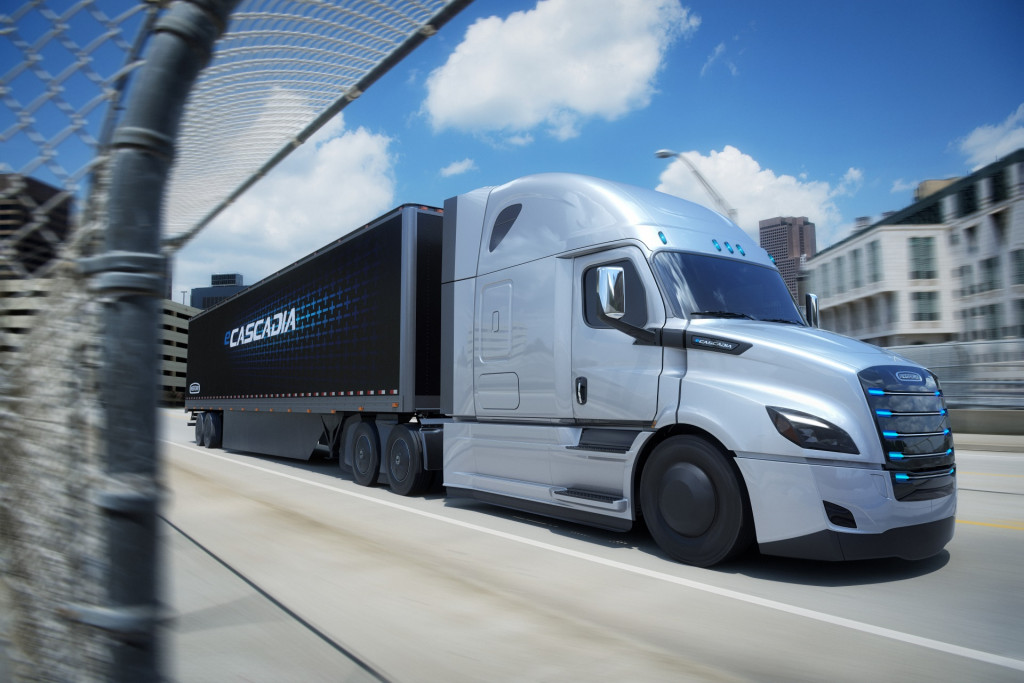Earlier this month, Portland General Electric and Daimler Trucks North America, which is headquartered in Portland, established a charging testbed for medium- and heavy-duty electric trucks.
Like the original “Electric Avenue” for electric-car charging (I attended the dedication in 2011), Daimler and PGE say that the effort, nicknamed “Electric Island,” is the first of its kind in the U.S.
In much the same way as Electric Avenue—but scaled up—Electric Island will offer up to nine charging stations in one place. The aim for the site, which will be greenhouse gas emissions-free (including the charging, of course) will help accelerate the development of zero-emissions commercial vehicles.

Electric Island - Portland, OR - Daimler Trucks and PGE (rendering)
Each up to “greater than one megawatt”—for a total for the site of up to 5 MW—available by spring of 2021. But because none of the higher-power hardware actually exists yet, an initial set of chargers, to be deployed soon, will include chargers that output 200 kW or less.
According to Daimler Trucks North America spokesperson Fred Ligouri, the initial round of charging hardware tested will be from “a number of different, leading manufacturers of equipment, including but not limited to: ABB, BTC Power, ChargePoint, Power Electronics, and Proterra.”
“We are exploring the future deployment of charging infrastructure capable of up to 1.5 MW as technology progresses,” Ligouri added.

Freightliner eCascadia electric semi-truck
Daimler Trucks hasn’t yet said what the role of the facility might be in decisions for upcoming electric trucks, but it’s hard to imagine it won’t play a part. The company has delivered at least six of its big eCascadia fully electric semis as part of a fleet test that puts the 250-mile semis in full-time use.
Tesla hasn’t yet delivered any of the trucks to customers for daily use. But in October the company said that it’s looking to deploy infrastructure with other parties, and aiming to settle on a standard long enough to be adequate for charges during mandated breaks.

Electric Avenue - Portland, OR
The original Electric Avenue—the one for cars—mainly tested Level 2 chargers, plus a few DC fast-chargers, and it didn’t charge any money to use the systems in exchange for data-sharing with the utility PGE and nearby Portland State. The list of charging hardware makers included several names long ago retired in the charging sector, like Eaton, GE, and Ecotality. It also included models from Zapcar, Myers Motors, and Arcimoto.
![Electric Avenue charging stations in Portland, Oregon [photo: Portland General Electric] Electric Avenue charging stations in Portland, Oregon [photo: Portland General Electric]](https://images.hgmsites.net/lrg/electric-avenue-charging-stations-in-portland-oregon-photo-portland-general-electric_100532764_l.jpg)
Electric Avenue charging stations in Portland, Oregon [photo: Portland General Electric]
In 2015, Model S sightings were frequent, and Leafs were everywhere, with CCS fast-charging charging hardware just starting to show up alongside better-established CHAdeMO hardware, Electric Avenue was moved and rededicated. This time the emphasis wasn’t on the hardware—supplied by Efacec and Clipper Creek—so much as the charging habits, and users only needed to pay for parking.
Portland was by no means the first to use the Electric Avenue moniker—and perhaps for an EV-focused project or exhibit, but it’s become the most widely known. The year before Portland set its street up, the Detroit Auto Show applied the name to a basement exhibit of EVs, including, including the Nissan Leaf, the BYD e6 and, as we reported, “a horrifying mix of low-speed and neighborhood electric vehicles and outright science projects.”

Electric Island - Portland, OR - Daimler Trucks and PGE (rendering)
Soon, there will be more chargers, on-site energy storage, solar power generation, and a Daimler building intended to showcase products and tech. Although it isn’t the kind of middle-of-the-city, flesh-mob spectacle of the original, it should help give by-the-books fleet managers what they need to take EV adoption higher.
